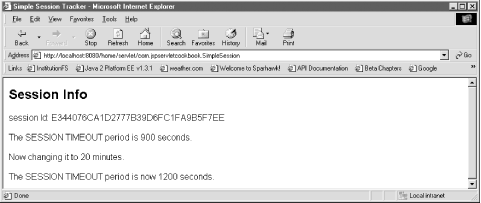Recipe 11.3 Setting the Session Timeout Programmatically
ProblemYou want to set a session timeout in your servlet code. SolutionUse the HttpServletRequest object's getSession( ) method to get a reference to the HttpSession object. Then change the timeout period programmatically by using the HttpSession.setMaxInactiveInterval(int seconds ) method. DiscussionThe HttpSession.setMaxInactiveInterval(int seconds ) method sets the timeout for a session individually , so that only the particular session object being operated upon is affected. Other servlets that do session tracking in the web application still use the session-timeout value in web.xml or, in the absence of this element, the server's default session-timeout value. Example 11-5 checks the timeout period for a session, then resets that timeout period to 20 minutes. Example 11-5. Resetting a default timeout period package com.jspservletcookbook; import java.util.Date; import java.text.DateFormat; import javax.servlet.*; import javax.servlet.http.*; public class SimpleSession extends HttpServlet { public void doGet(HttpServletRequest request, HttpServletResponse response) throws ServletException, java.io.IOException { response.setContentType("text/html"); java.io.PrintWriter out = response.getWriter( ); HttpSession session = request.getSession( ); out.println("<html>"); out.println("<head>"); out.println("<title>Simple Session Tracker</title>"); out.println("</head>"); out.println("<body>"); out.println("<h2>Session Info</h2>"); out.println("session ID: " + session.getId( ) + "<br><br>"); out.println( "The SESSION TIMEOUT period is " + session.getMaxInactiveInterval( ) + " seconds.<br><br>"); out.println( "Now changing it to 20 minutes.<br><br>"); session.setMaxInactiveInterval(20 * 60); out.println("The SESSION TIMEOUT period is now " + session.getMaxInactiveInterval( ) + " seconds."); out.println("</body>"); out.println("</html>"); } } Figure 11-2 shows the result of requesting this servlet in a web browser. Figure 11-2. Getting session-timeout info This servlet gets the HttpSession object with the HttpServletRequest class's getSession( ) method. Whatever the servlet's default timeout period is, say, 30 minutes, Example 11-5 changes the accessed session's timeout to 20 minutes: session.setMaxInactiveInterval(20 * 60); Remember, this method alters the default session-timeout interval only for the session associated with the users who request this servlet. Why would some users get a different timeout interval than others? Perhaps web- user testing at your organization has indicated that a session timeout of five minutes is more appropriate for your shopping cart- related servlets, whereas some chart- or map-creation servlets require the default timeout of 30 minutes or more, since their users might linger over the complex images in their browsers for a long period. In most web applications, the session timeout is set (or altered ) in the deployment descriptor, and you will not have to dynamically change the timeout in the servlet code. See AlsoRecipe 11.1 on configuring the session timeout; Recipe 11.2 on setting the session timeout in all Tomcat applications; Recipe 11.4 on checking the validity of a session; Chapter 1 on web.xml ; Chapter 7 of the Servlet v2.3 and v2.4 specifications on sessions; the session-tracking sections of Java Servlet Programming by Jason Hunter (O'Reilly) and JavaServer Pages by Hans Bergsten (O'Reilly). |
EAN: 2147483647
Pages: 326
- The Four Keys to Lean Six Sigma
- When Companies Start Using Lean Six Sigma
- Making Improvements That Last: An Illustrated Guide to DMAIC and the Lean Six Sigma Toolkit
- The Experience of Making Improvements: What Its Like to Work on Lean Six Sigma Projects
- Six Things Managers Must Do: How to Support Lean Six Sigma